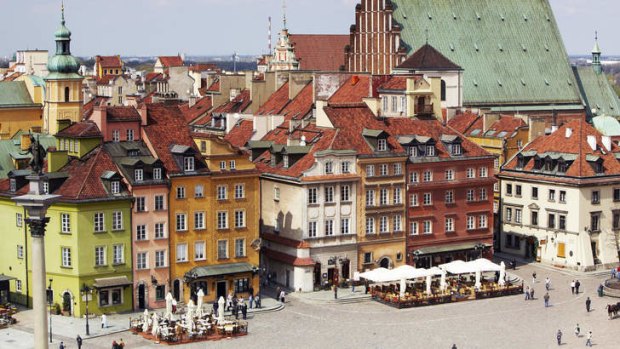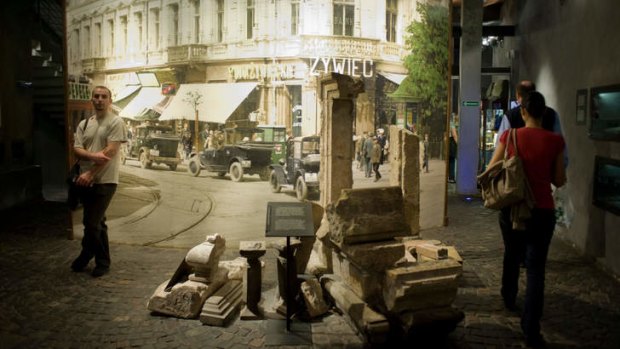
Restored: Warsaw Old Town.Credit: Getty Images
History has been reconstructed so well in Warsaw that David Whitley finds the fakes difficult to pick.
On one of the few corners of Warsaw's Old Town not inhabited by a busker, a photograph grabs attention. Taken in September 1945, it shows General Dwight D. Eisenhower strolling through what appears to be a lava field.
Rubble is piled waist-high, and the buildings in the background look like the smashed teeth of a mouth that has been taken to with a baseball bat. Then you look up, compare the outlines of the buildings, and realise you're standing where Eisenhower is in the photo.

Inside the Warsaw Rising Museum.Credit: Alamy
Today's Old Town is as pretty as any in Europe. The pastel-coloured buildings provide an agreeable backdrop to the sea of terrace-cafe umbrellas. The streets offer alternating galleries, trinket shops and ice-cream stalls. But, barring the odd exception, it's all a glorious fake. Warsaw's Old Town is arguably history's greatest reconstruction project.
The Warsaw Rising Museum, about two kilometres from the Old Town, tells of the numerous tragedies and betrayals that befell Warsaw during the Second World War.
The tale of the Warsaw Rising is a heartbreaker. On August 1, 1944, the Home Army finally came out of the shadows and the people of Warsaw went into armed rebellion against the Nazi occupiers. They thought Allied back-up was on the way, but the Brits and Americans wavered while they awaited word from Stalin. The Soviet leader held his troops back, so that when the Red Army finally marched in, any possible resistance to a new communist regime had been crushed.
The rising lasted two months, with the insurgents hemmed into the Old Town for much of it. When the inevitable surrender was signed, the Nazis were ruthless. They destroyed 84 per cent of Warsaw before the Red Army later chased them out.
The showpiece of the museum is a 3D film that takes you on a virtual flight over a digitally created 1945 Warsaw. The scale of the damage is scarcely imaginable.
The decision to rebuild was taken early, and the work completed remarkably quickly. Photos on display at Dom Spotkan z Historia show first the damage, then the people trying to fix it. UNESCO regards the archives of the Office for the Reconstruction of the Capital as some of the most important documents in history, and has put them on its Memory of the World list. Copies of some of the maps, sketches and photos contained within the archive are on display. Without them, the almost perfectly faithful reconstruction of the Old Town would not have been possible.
The most ambitious projects were completed while Stalin was throwing the money around. The merchant houses of the Old Town square were resurrected by 1953 and St John's Cathedral reconsecrated in 1960.
A major part of the restoration was delayed, however. The Royal Castle was left as a wall with two blown-out windows in 1945. The authorities didn't originally want it rebuilt - it was seen as a symbol of feudalism and nobility. This stance was softened in 1971 and a collection box was put in the Castle Square to help fund the work. The entire 13-year rebuild was paid for by public donations.
During the war, members of staff had done all they could to preserve parts of the castle. As many of them as possible were incorporated in the restoration. Furniture and artworks were also saved. And the greatest compliment you can pay is that it's extraordinarily difficult to tell where the originals end and the fakery begins.
David Whitley was a guest of Accor Hotels.
FAST FACTS
Getting there There are no one-stop routes to Warsaw from Sydney. Best prices — sometimes less than $2000 — are often available with KLM (klm.com.au). This means a Malaysia Airlines codeshare to Kuala Lumpur, an onward flight to Amsterdam, then a connection to Warsaw.
Staying there The Mercure Grand Warszawa, 28 Krucza Street, +48 22 583 2100, see accorhotels.com, from 250 zloty ($79), offers excellent value for money, with accommodation in bright, colourful rooms that have been recently refurbished.
See + do Warsaw Uprising Museum: 79 Grzybowska, +48 22 539 7905, see 1944.pl. Entrance to museum plus 3D film costs 14 zloty.
Dom Spotkan z Historia: 20 Karowa Street, +48 22 255 0505, see dsh.waw.pl. Free entry.
Royal Castle: 4 Plac Zamkowy, +48 22 355 5170, see zamek-krolewski.pl. Entrance costs 22 zloty, with the audio guide costing another 17 zloty.
Sign up for the Traveller Deals newsletter
Get exclusive travel deals delivered straight to your inbox. Sign up now.